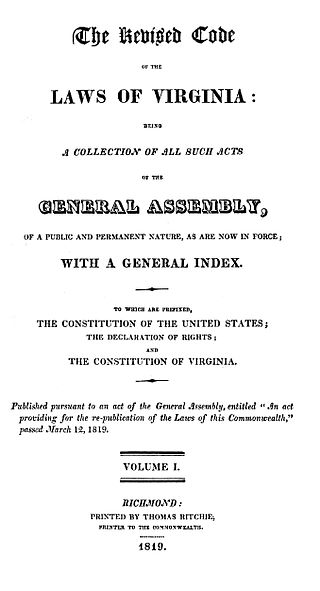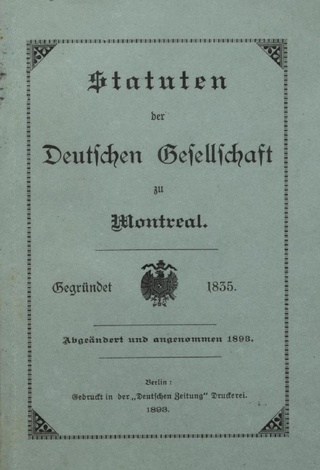
The Constitution of Canada is the supreme law in Canada. It outlines Canada's system of government and the civil and human rights of those who are citizens of Canada and non-citizens in Canada. Its contents are an amalgamation of various codified acts, treaties between the Crown and Indigenous Peoples, uncodified traditions and conventions. Canada is one of the oldest constitutional monarchies in the world.

The United States Code is the official codification of the general and permanent federal statutes of the United States. It contains 53 titles. The main edition is published every six years by the Office of the Law Revision Counsel of the House of Representatives, and cumulative supplements are published annually. The official version of these laws appears in the United States Statutes at Large, a chronological, uncodified compilation.

The legal system of Canada is pluralist: its foundations lie in the English common law system, the French civil law system, and Indigenous law systems developed by the various Indigenous Nations.

The Constitution Act, 1867, originally enacted as the British North America Act, 1867, is a major part of the Constitution of Canada. The act created a federal dominion and defines much of the operation of the Government of Canada, including its federal structure, the House of Commons, the Senate, the justice system, and the taxation system. In 1982, with the patriation of the Constitution, the British North America Acts which were originally enacted by the British Parliament, including this Act, were renamed. However, the acts are still known by their original names in records of the United Kingdom. Amendments were also made at this time: section 92A was added, giving provinces greater control over non-renewable natural resources.
The Massachusetts General Laws is a codification of many of the statutes of the Commonwealth of Massachusetts. The Commonwealth's laws are promulgated by an elected bicameral ("two-chamber") legislative body, the Massachusetts General Court. The resulting laws—both Session Laws and General Laws—together make up the statutory law of the Commonwealth.
In certain jurisdictions, including the United Kingdom and other Westminster-influenced jurisdictions, as well as the United States and the Philippines, primary legislation has both a short title and a long title.

The Code of Virginia is the statutory law of the U.S. state of Virginia, and consists of the codified legislation of the Virginia General Assembly. The 1950 Code of Virginia is the revision currently in force. The previous official versions were the Codes of 1819, 1849, 1887, and 1919, though other compilations had been printed privately as early as 1733, and other editions have been issued that were not designated full revisions of the code.
Citation of United Kingdom legislation includes the systems used for legislation passed by devolved parliaments and assemblies, for secondary legislation, and for prerogative instruments. It is relatively complex both due to the different sources of legislation in the United Kingdom, and because of the different histories of the constituent countries of the United Kingdom.

The Connecticut General Statutes, also called the General Statutes of Connecticut and abbreviated Conn. Gen. Stat., is a codification of the law of Connecticut. Revised to 2017, it contains all of the public acts of Connecticut and certain special acts of the public nature, the Constitution of the United States, the Amendments to the Constitution of the United States, and the Constitution of the State of Connecticut, including its 31 amendments adopted since 1965. The earliest predecessor to the currently in force codification dates to 1650.
An Appropriation Act is an Act of the Parliament of the United Kingdom which, like a Consolidated Fund Act, allows the Treasury to issue funds out of the Consolidated Fund. Unlike a Consolidated Fund Act, an Appropriation Act also "appropriates" the funds, that is allocates the funds issued out of the Consolidated Fund to individual government departments and Crown bodies. Appropriation Acts were formerly passed by the Parliament of Great Britain.
Because the country contains two major language groups and numerous other linguistic minorities, in Canada official languages policy has always been an important and high-profile area of public policy.

Human rights in Canada have come under increasing public attention and legal protection since World War II. Prior to that time, there were few legal protections for human rights. The protections which did exist focused on specific issues, rather than taking a general approach to human rights.

The Piracy Act 1850, sometimes called the Pirates Repeal Act 1850, is an Act of the Parliament of the United Kingdom. It relates to proceedings for the condemnation of ships and other things taken from pirates and creates an offence of perjury in such proceedings.
A revised edition of the statutes is an edition of the Revised Statutes in the United Kingdom. These editions are published by authority.

An Act to incorporate the German Society of Montreal is a public act of the Parliament of the Province of Canada, introduced, passed and assented to in the 3rd Session of the 8th Parliament in 1865, the 28th year of the reign of Queen Victoria. The purpose of the legislation was to vest the German Society of Montreal, a charitable association founded in 1835 with corporate powers to better achieve its mission.

Section 93 of the Constitution Act, 1867 is a provision of the Constitution of Canada relating to education. It gives the provinces a broad legislative jurisdiction over education. Section 93 also contains guarantees of publicly funded denominational and separate schools for Catholic or Protestant minorities in some provinces.

Section 94 of the Constitution Act, 1867 is a provision of the Constitution of Canada allowing the federal Parliament to implement uniform laws relating to property and civil rights, and procedure in the civil courts, in three of the original provinces: New Brunswick, Nova Scotia, and Ontario. The power under section 94 cannot be used without the consent of those provinces, as those subject matters are normally within exclusive provincial jurisdiction. The power has never been used.

Section 1 of the Constitution Act, 1867 is a provision of the Constitution of Canada, setting out the title to the Act.

Section 2 of the Constitution Act, 1867 is a repealed provision of the Constitution of Canada relating to the monarch of Canada. It defined the term "Her Majesty the Queen" for the purposes of the Constitution Act, 1867.

Section 37 of the Constitution Act, 1867 is a provision of the Constitution of Canada relating to the composition of the House of Commons, the lower house of the federal Parliament of Canada.








